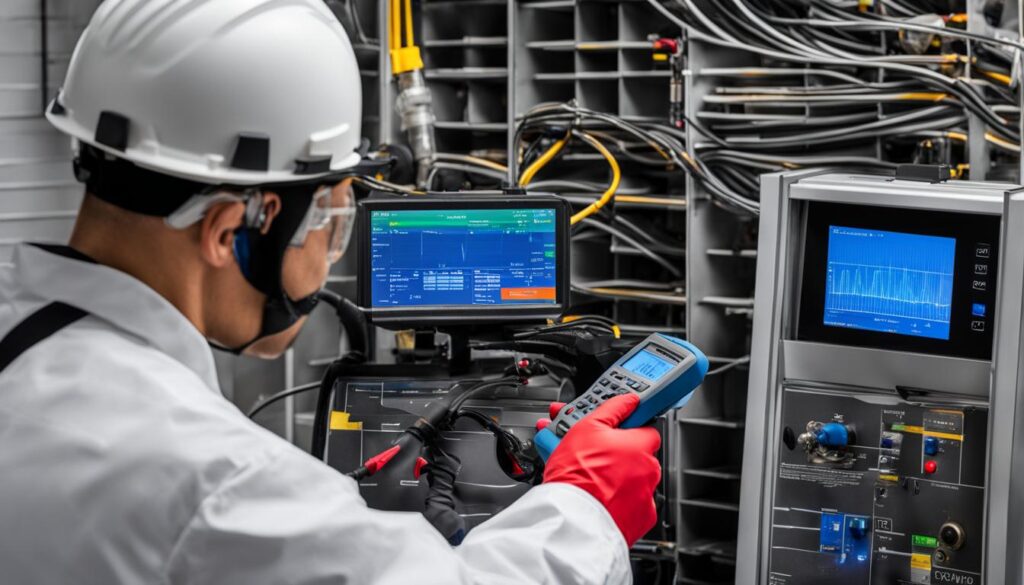Disclosure: This Post Contains Affiliate Links; We earn a commission on purchases.
EMF, or electromagnetic field, is an invisible force emitted by electronic devices such as mobile phones and wireless routers. With the increasing use of these devices, it is important for consumers to understand the potential health effects and safety regulations surrounding EMF exposure. In this article, we will explore the reasons why EMF testing and certification are crucial for mobile devices, the types of EMF pollution that can be identified through testing, and the potential dangers of EMF exposures.
Key Takeaways:
- EMF testing and certification ensure the safety and compliance of mobile devices with EMF regulations.
- Through EMF testing, various types of EMF pollution can be identified, including power system EMF, radiofrequency (RF) EMF, and toxic light frequencies.
- EMF exposures can have thermal and non-thermal effects on human health, potentially leading to occupational hazards and electro sensitivity.
- The testing and certification process for devices vary by country, following regulations such as FCC, Industry Canada guides, EU Declaration of Conformity, ACA registration, VCCI marking, and MSIP approval.
- Onsite EMF testing and specific absorption rate (SAR) testing are crucial in evaluating EMF exposure levels and ensuring safety in the workplace. Electromagnetic shielding can also be used to reduce EMF emissions.
Reasons You Should Get an EMF Inspection
Addressing health concerns should be a top priority, especially when it comes to the potential risks associated with electromagnetic fields (EMF). Exposure to high-frequency EMF sources can have adverse effects on sleep, causing insomnia and potentially leading to more severe health conditions, such as cancer. To ensure the safety of yourself and your family, it is crucial to consider getting an EMF inspection for your mobile device.
During an EMF inspection, experts can identify EMF-affected areas in your home or workplace. This knowledge allows you to take necessary precautions and implement measures to protect yourself and your loved ones. By understanding the specific areas that are affected by EMF, you can create safe spaces that minimize exposure and promote overall well-being.
In addition to addressing health concerns, an EMF inspection also plays a crucial role in ensuring safety. It helps detect potential interference with electronic devices and systems. For individuals who work remotely or in EMF-sensitive environments, an EMF inspection provides valuable insights to create a safe work environment and minimize occupational hazards.
Moreover, reducing EMF exposure not only promotes personal safety but also has a positive environmental impact. High levels of electromagnetic radiation contribute to energy wastage. By detecting and mitigating these levels through an EMF inspection, you can actively contribute to energy conservation and reduce the environmental footprint.
“By detecting and mitigating high levels of electromagnetic radiation, an EMF inspection can help mitigate potential hazards and ensure the proper functioning of sensitive electronic gadgets.”
Overall, the benefits of an EMF inspection are far-reaching. By addressing health concerns, ensuring safety, and reducing environmental impact, EMF inspections create safe and healthy environments for individuals and communities alike.
Types of EMF Pollution Inspected in an EMF Home Testing
During an EMF home testing, it is crucial to identify and address various types of EMF pollution that can have adverse effects on health. These types of pollution can originate from different sources in our environment, including power systems, radiofrequency (RF) sources, and toxic light frequencies.
Power System EMF:
Power system EMF refers to the electromagnetic fields generated by electrical wiring, circuit breakers, transformers, and power distribution systems within a home. These fields can emit low-frequency radiation that can permeate the living environment and potentially pose health risks to occupants.
Radiofrequency (RF) EMF:
Radiofrequency EMF inspection focuses on sources such as smart sensors, smart appliances, cellular devices, Bluetooth devices, Wi-Fi routers, and home automation systems. These technologies emit high-frequency radiation that can penetrate through walls and other obstacles, potentially causing prolonged exposure and associated health concerns.
Toxic Light Frequencies:
Toxic light frequencies are emitted from manufactured lighting sources such as LED lights, fluorescent lights, CFL lights, street lights, and appliance displays. These sources release high-frequency EMF that can contribute to the overall EMF pollution in our environment and potentially affect our well-being.
By conducting an EMF home testing, individuals can gain a better understanding of the types of EMF pollution present in their living space and take necessary measures to mitigate their exposure. It is essential to create a safe and healthy environment for ourselves and our loved ones.
| EMF Pollution Type | Sources | Frequency Range |
|---|---|---|
| Power System EMF | Electrical wiring, circuit breakers, transformers, power distribution systems | Low-frequency |
| Radiofrequency (RF) EMF | Smart sensors, smart appliances, cellular devices, Bluetooth devices, Wi-Fi routers, home automation systems | High-frequency |
| Toxic Light Frequencies | LED lights, fluorescent lights, CFL lights, street lights, appliance displays | High-frequency |

Understanding the different types of EMF pollution and their sources is the first step towards creating a healthier living environment. By addressing these sources, individuals can reduce their exposure to potentially harmful EMF and promote overall well-being.
Dangers of EMF Exposures
EMF exposures can pose various hazards to human health. One of the dangers associated with EMF exposures is the thermal effect, where tissues absorb energy and heat, potentially damaging cells and tissues. This can lead to adverse health effects and requires careful consideration.
In addition to thermal effects, EMF can also have non-thermal effects that are still being studied. These effects encompass a range of impacts at the cellular, molecular, neurological, hormonal, reproductive, and developmental levels. While the full extent of these non-thermal effects is not yet fully understood, they are a cause for concern.
Occupational hazards are another consequence of high EMF levels. Individuals working in environments with elevated EMF exposure, such as electrical power stations or telecommunication facilities, are at an increased risk of experiencing health issues and should be protected through appropriate measures and regular EMF inspections.
Furthermore, some individuals may be electro-sensitive, experiencing symptoms like headaches, fatigue, and other health discomforts in the presence of EMF. Identifying and mitigating exposure levels through EMF testing is crucial for managing these sensitivities and ensuring a healthier environment for everyone.
It is essential to thoroughly understand these dangers associated with EMF exposures in order to fully grasp the importance of EMF inspections. By recognizing and addressing the potential hazards of EMF, individuals and organizations can take proactive steps to minimize risks and safeguard their well-being.
Expert Insight
“EMF exposures can have significant impacts on human health, both in the short term and long term. It is crucial for individuals and employers to recognize the potential dangers and implement measures to mitigate risks. Through regular EMF inspections and proper testing, we can identify and address areas of concern, fostering a safer and healthier environment for all.” – Dr. Emily Davis, EMF Specialist
Case Study
“We conducted an EMF inspection in a workplace that reported numerous cases of employee health issues. The test revealed high EMF levels originating from faulty electrical systems and improperly shielded equipment. By rectifying these issues and implementing mitigation measures, we were able to significantly improve the working conditions and reduce health complaints among employees.” – Smithson Technology Solutions
Comparison of Thermal and Non-Thermal Effects of EMF Exposures
| Effects | Thermal Effects | Non-Thermal Effects |
|---|---|---|
| Definition | Related to energy absorption and heating of tissues | Includes cellular, molecular, neurological, hormonal, reproductive, and developmental impacts |
| Examples | Heat-related injuries, tissue damage | Altered cell function, DNA damage, disrupted hormone production |
| Evidence | Well-documented and extensively researched | Still being studied, but evidence suggests potential risks |
| Regulatory Guidelines | EMF exposure limits based on thermal effects | Non-thermal effects shaping future regulations and guidelines |
EMF Testing and Certification Process for Devices
The testing and certification process for devices to ensure compliance with EMF regulations varies depending on the country. Here is an overview of the regulatory requirements and certification processes in different regions:
United States (FCC regulations)
In the United States, devices must comply with the Federal Communications Commission (FCC) regulations. The FCC sets specific guidelines and limits for electromagnetic radiation emitted by devices. Manufacturers are required to test their devices for compliance and obtain FCC certification before they can be marketed and sold in the country.
Canada (Industry Canada guides)
In Canada, devices must follow the guidelines set by Industry Canada (IC). IC provides detailed information and testing methods to assess the electromagnetic emissions of devices. Manufacturers are responsible for testing their devices and ensuring compliance with IC’s guidelines before they can be distributed in the Canadian market.
European Union (Declaration of Conformity)
In the European Union, devices need to comply with the applicable EU directives and regulations. Manufacturers must conduct EMF testing and prepare a Declaration of Conformity, which confirms that their devices meet the essential requirements of the EMC Directive. The Declaration of Conformity serves as a declaration by the manufacturer that their product complies with the relevant EU directives and regulations.
Australia (Australian Communications Authority registration)
In Australia, devices must be registered with the Australian Communications Authority (ACA) to ensure compliance with EMF regulations. Manufacturers are required to test their devices and submit the relevant documentation to the ACA for registration. The registration process ensures that devices meet the minimum requirements of EMF standards and are safe for use in Australia.
Japan (VCCI marking)
In Japan, devices must have VCCI marking to demonstrate compliance with EMF regulations. VCCI (Voluntary Control Council for Interference) is an organization that sets guidelines and standards for electromagnetic emissions in Japan. Manufacturers must test their devices and obtain VCCI marking to show that their products meet the required standards and are compatible with the electromagnetic environment in Japan.
Korea (MSIP approval for KC Mark)
In Korea, devices require MSIP (Ministry of Science and ICT) approval for KC Mark certification. The MSIP evaluates devices to ensure compliance with EMF regulations and issues the KC Mark certification, indicating that the devices meet the electromagnetic compatibility requirements in Korea. Manufacturers must submit their products for testing and obtain MSIP approval before selling them in the Korean market.
Ensuring that devices undergo the necessary EMF testing and obtain the required certifications is essential to guarantee their compliance with EMF regulations and safety standards. By adhering to these certification processes, manufacturers can provide consumers with devices that are safe for use and meet the minimum requirements of prescribed EMF standards in each region.
Onsite EMF Testing and Specific Absorption Rate (SAR) Testing
Onsite EMF testing is a crucial step in assessing the levels of electromagnetic fields in different environments. This type of testing is particularly important in the workplace, where the health and safety of employees are of utmost concern. Compliance with specific directives and regulations, such as the EU Directive 2013/35/EU and UK Regulation 588/2016, is required to monitor EMF exposure limits in the workplace.
In addition to EMF testing, Specific Absorption Rate (SAR) testing is another essential aspect of ensuring device safety. SAR testing focuses on measuring the rate at which wireless portable devices absorb radio frequency (RF) energy. By conducting SAR testing, manufacturers can ensure that their devices meet the safety standards for RF energy exposure.
The Importance of Onsite EMF Testing
- Assesses electromagnetic field levels in different environments
- Evaluates the potential health risks associated with EMF exposure
- Ensures compliance with EU Directive 2013/35/EU and UK Regulation 588/2016
- Protects the health and safety of employees in the workplace
The Significance of SAR Testing
- Measures the specific absorption rate of radio frequency energy
- Verifies that wireless portable devices meet safety standards for RF energy exposure
- Ensures the safe use of devices without posing harm to users
In addition to testing, electromagnetic shielding is employed to reduce or block EMF through barriers made of conductive or magnetic materials. To assess the effectiveness of these materials, shielding effectiveness testing is conducted.
To give you a better understanding, here’s a simplified diagram of the EMF testing and certification process:
| Stage | Description |
|---|---|
| 1 | Onsite EMF testing to assess field levels |
| 2 | Specific Absorption Rate (SAR) testing to measure RF energy absorption |
| 3 | Electromagnetic shielding to reduce or block EMF |
| 4 | Shielding effectiveness testing to determine barrier efficacy |

By conducting onsite EMF testing, SAR testing, and shielding effectiveness testing, manufacturers can ensure their devices meet the necessary safety standards for EMF exposure. These tests are essential in promoting the responsible use of electronic devices and safeguarding the health of individuals.
Conclusion
In conclusion, EMF testing and certification for devices are essential in ensuring the safety and compliance of electronic devices with regulations. Through EMF inspections, areas of high EMF exposure can be identified and mitigated, creating a safer environment for both residential and occupational settings. It is crucial to understand the potential dangers of EMF exposures and take proactive steps to reduce EMF pollution.
Manufacturers play a significant role in ensuring the safety of consumers by conducting thorough testing and certification processes. By providing EMF-compliant devices that meet the highest standards of safety and electromagnetic compatibility, manufacturers contribute to the responsible use of electronic devices in today’s technology-driven world.
EMF testing and certification not only protect individuals from potential health hazards but also promote a healthier and more sustainable environment. By raising awareness and implementing stringent testing and certification standards, we can all create a safer and more EMF-conscious society.
Source Links
- https://eliteinspections.com/why-should-i-consider-an-emf-inspection/
- https://www.gao.gov/assets/gao-12-771.pdf
- https://www.intertek.com.hk/emc/

Subscribe to Our Newsletter










